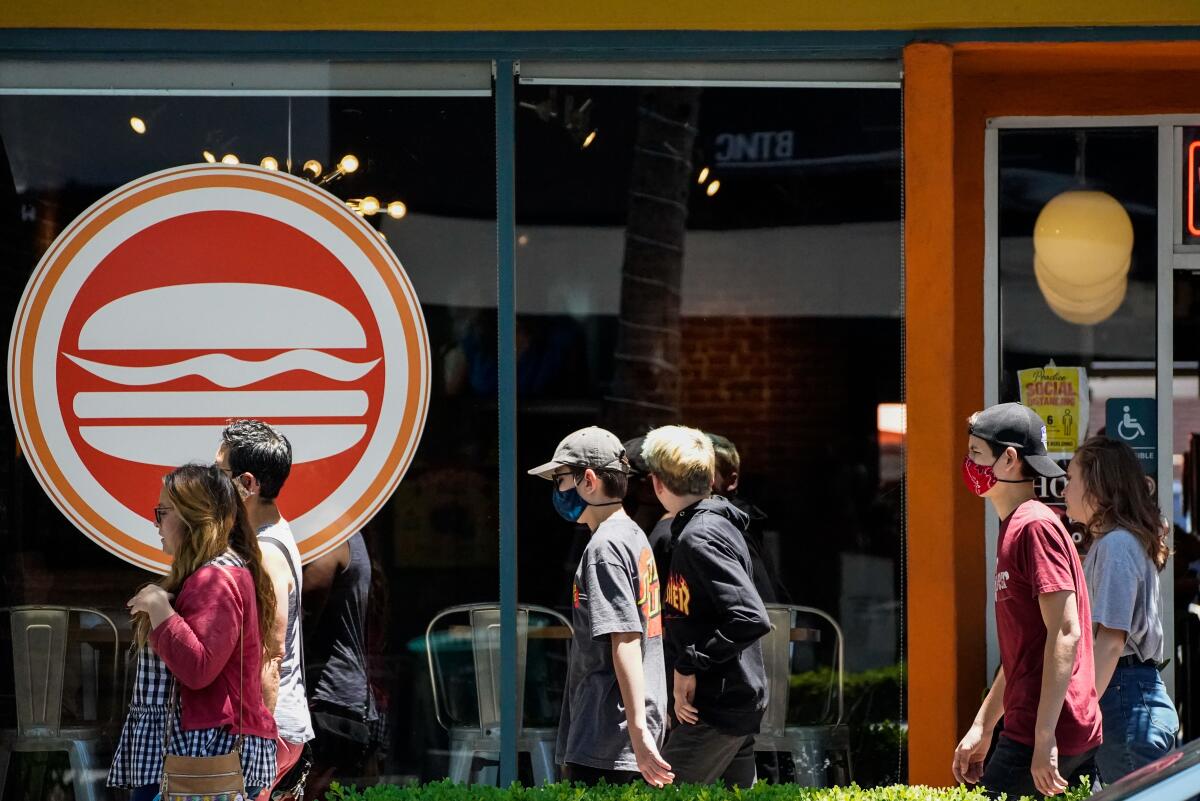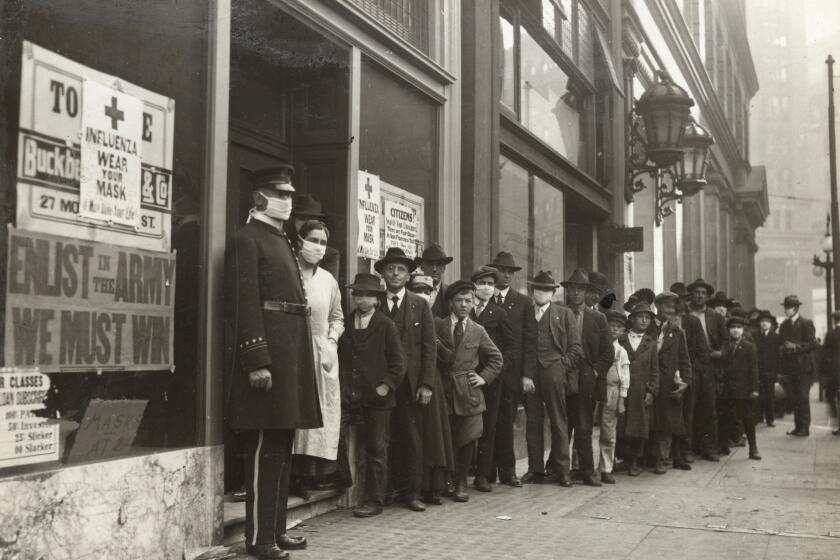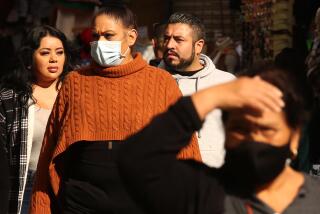A revolt against wearing masks creates a new coronavirus danger as California reopens

- Share via
As California rapidly reopens its economy, health officials have made clear the only way to avoid a wave of new coronavirus infections is with strict safety rules, including social distancing, limits on the capacity of businesses and wearing face coverings when around other people.
But a mask rebellion is underway in some parts of the state, with residents pushing back on mandatory face-covering rules even with coronavirus cases on the rise and as more businesses open their doors and some people yearn to return to old routines.
The potency of mask politics became clear this week in Orange County, where the health officer resigned after weeks of attacks — and a death threat — over her mandatory mask rules. Her replacement on Thursday rescinded the rules amid intense pressure from the Board of Supervisors.
Instead, Orange County “strongly recommends” wearing masks in public settings, and the county’s top health official was left to explain the change even while acknowledging face coverings could prevent more deaths.
“I want to be clear: This does not diminish the importance of face coverings,” said Orange County Health Care Agency Director Dr. Clayton Chau, who is now also the interim health officer. “I stand with the public health experts and believe wearing cloth face coverings helps to slow the spread of COVID-19 in our community and save lives.”
Other counties have also buckled to public pressure. Fresno County had a face mask rule for less than a day before it was pulled back. Riverside and San Bernardino pulled their orders after blowback. Stockton’s mayor, Michael Tubbs, proposed face covering rules but failed to get any support from the City Council this week.
Health experts expressed alarm at Orange County’s actions and the large rebellion about masks, saying it will make it harder to prevent new outbreaks of coronavirus.
“It’s the only way we get back to work — it’s to mask,” said Dr. Kirsten Bibbins-Domingo, UC San Francisco chair of the Department of Epidemiology and Biostatistics. “All of the data tells us ... it’s pretty clear that masking is the element that changes the trajectories of the COVID pandemic.”
There’s increasing evidence that face coverings are essential to allowing a broader reopening. Places that have kept coronavirus transmission under control, such as Hong Kong and Taiwan, have virtually universal wearing of masks in public.
A recent study out of Germany found that face masks reduce the daily growth rate of reported infections by around 40%. Another study, published Thursday in the Proceedings of the National Academy of Sciences, concluded that “wearing of face masks in public corresponds to the most effective means to prevent interhuman transmission.”
In one Missouri salon, no customers became infected with the virus despite two hairstylists being sick — and scientists believe it was because they were wearing face masks. And many countries where masking is socially routine, including Japan, have not seen an out-of-control national epidemic.
“They haven’t seen the large spikes, because there’s a strong universal masking culture,” Bibbins-Domingo said.
Of California’s 15 most populous counties, Los Angeles, San Diego, Santa Clara, Alameda, Sacramento, Contra Costa, San Francisco and San Mateo require mask wearing in public, while Orange, Riverside, San Bernardino, Fresno, Kern, Ventura and San Joaquin do not.
The Orange County battle began in May, when then-county health officer Dr. Nichole Quick issued an order mandating that county residents and visitors wear cloth face coverings while in a public place, at work or visiting a business where they are unable to stay six feet apart.
The switch set off a firestorm of controversy as some residents and elected officials challenged the need for the widespread use of face coverings as more businesses in the region continued to reopen.
Quick herself became a target for criticism during county Board of Supervisors meetings, with some residents castigating her for the order. During one meeting, public speakers displayed a poster showing Quick’s photo with a Hitler mustache and swastikas.
The Orange County Sheriff’s Department provided a security detail for the doctor after she received what officials deemed to be a death threat during a meeting last month.
After several intense weeks defending her order, Quick resigned Monday.
On Tuesday, Chau stepped into Quick’s role and was immediately peppered with questions from elected officials about the need for a mandatory mask order. Members of the public could be heard shouting in the background as Chau responded to questions from the board.
Supervisors pushed Chau for a definitive answer about when he planned to lift the requirement.
“There’s always going to be community infection going on,” Supervisor Don Wagner said. “There’s always flu infection going on. Are you telling us masks, in your professional opinion, are going to be necessary until the end of time or until there’s a vaccine or what?”
The dispute over the requirement has unfolded as the number of COVID-19 cases and deaths continue to rise in Orange County.
Last week, Orange County reported 1,179 new coronavirus infections — a weekly record in the course of the pandemic, and up 22% from the previous week, according to a Times analysis.
Hospitalizations are up 34% from a month ago. Last week, there were an average of nearly 400 people in hospitals in Orange County daily for confirmed or suspected coronavirus infection; a month ago, it was nearly 300.
And last week, Orange County recorded 30 coronavirus deaths, the second-highest weekly toll. As of Thursday, there were a total of 7,987 confirmed cases and 202 deaths in Orange County.
The California Medical Assn., which represents doctors across the state, has said mandating face masks is an appropriate public policy, and its immediate past president, Dr. David Aizuss, said lawmakers should have supported Quick.
“On behalf of the California Medical Assn., it’s our opinion that mandatory face masking is appropriate and Orange County should’ve backed her up. Our position is that this is being driven by ignorance and politics instead of science,” Aizuss said. He also criticized the Board of Supervisors for not backing up her health orders.
“Local public servants should be supporting local health officers to do what they’re doing to protect the public and to protect public health,” Aizuss said.
The Orange County Medical Assn. this week called Quick’s resignation a “dangerous precedent that should concern all of us” and said that “we must ... not allow bullying to drive the health recommendations that can keep us safe and healthy.”
“This public health crisis is not over. As we begin to reopen our county, the science is clear: wearing a face covering can help slow the spread of this deadly virus,” Dr. Diana Ramos, president of the Orange County Medical Assn., said in a statement.
Experts rejected the unfounded charge expressed by opponents of mandatory masks that face coverings pose a danger to people’s oxygen levels. “No, there’s nothing to that. There’s all sorts of conspiracy theories about low oxygen and high CO2 levels,” said Dr. Otto Yang, an infectious diseases expert at UCLA. “It’s really not an issue.”
Many health officials say that face coverings are an integral tool in the fight against COVID-19 — as they can block transmission of the respiratory droplets released by asymptomatic people when breathing or talking.
Research published by the journal Disaster Medicine and Public Health Preparedness in 2013 found that homemade cloth masks “significantly” reduced the amount of potentially infectious droplets expelled by the wearer.
L.A. County Public Health Director Barbara Ferrer has routinely touted the health benefits of wearing face coverings in public. That, along with other practices like physical distancing and regular hand-washing, can stave off a spike in coronavirus infections, she has said.
“Masks provide a hell of a lot of protection. And I’m more comfortable relaxing things if everybody is wearing masks than if they weren’t,” Dr. George Rutherford, a UC San Francisco epidemiologist and infectious diseases expert, said recently.
At the reopening Thursday of South Coast Plaza, many shoppers said they were not taking any chances — even some who were skeptical about the benefit of masks.
California lessons from the 1918 pandemic: San Francisco dithered; Los Angeles acted and saved lives
San Francisco went mask crazy. Los Angeles shut down early and stayed closed longer, but not long enough. Some lessons from the 1918 Spanish flu.
Pay Wykoff — a 65-year-old Irvine resident who waited weeks to come to mall to get a watch battery and find a Father’s Day present — wore a yellow hand-sewn mask but said she thought it was unnecessary.
“Not everyone agrees that masks are helpful,” Wykoff said. “I think masks are hurtful because you’re breathing in your own germs.”
Times staff writers Sandhya Kambhampati and Iris Lee contributed to this report.
More to Read
Sign up for Essential California
The most important California stories and recommendations in your inbox every morning.
You may occasionally receive promotional content from the Los Angeles Times.















